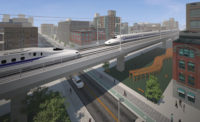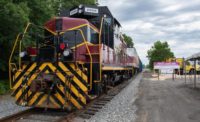A U.K. joint venture building a 4.5-km extension to Londons Docklands Light Railway (DLR) won a contract to design, build, finance and operate another 2.5 km of track, raising the teams share on the 26-km system to $640 million.
 |
| Italians On Deck. Rizzani de Eccher has concrete contract. (Photo by Peter Reina for ENR) |
An equally owned joint venture of contractor Amec PLC., London, and the Royal Bank of Scotland, Edinburgh, hopes to sign the new $380-million contract with Docklands Light Railway Ltd. this spring, when work starts on Londons east side.
Under the 30-year contract, the joint venture, Woolwich Arsenal Rail Enterprises Ltd. (WARE), will finance the project with equity and bank loans and maintain the track. Turnkey construction and maintenance will be handled by Amec subsidiaries under separate contracts.
The new extension will run from an existing 900-m-long trench by London City airport under the River Thames to Woolwich on the south side. The joint venture City Airport Rail Enterprises Ltd. (CARE), owned by the same firms, is on course to complete the 4.5-km,
largely elevated extension to the trench late this year.
Already working on the DLR "without a doubt" helped the joint venture win the new contract, says Bob Goldring, Amecs project director on the current extension work. Precasting facilities used for its concrete viaduct could be converted to produce linings for the new tunnel, he says.
Goldrings contract for CARE follows the north river bank from a junction near Canning Town on more than 2.8 km of viaduct plus embankment and the trench. Including construction and long-term maintenance, the contract is worth $570 million at todays prices, says Harvey Pownall, CAREs general manager.
Amecs largest viaduct subcontract is $21 million, with Rizzani de Eccher S.p.A, Udine, Italy. It covers casting and erecting concrete deck sections. "We worked with them before in Canada on a very similar system," says Goldring.
Designed for Amec by Halcrow Group Ltd., London, the 10-m-wide viaduct has 69 spans on a single row of piers. They are going up in generally 3-m-long precast segments either one span at a time, or as balanced cantilevers.
Rizzani is using the same 480-tonne gantry for both operations. For 60 typical spans, segments come by road to be hoisted and held by the gantry until they are stressed and stitched together. For longer spans, the gantry turns to balanced cantilever mode.
Starting early in 2003, the contractor first used four molds to cast segments. It added a fifth last year to work around rebar delivery problems caused by the global steel shortage, says Goldring.



Post a comment to this article
Report Abusive Comment